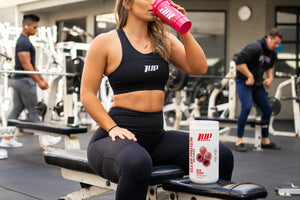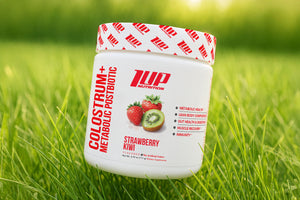Joint pain affects millions of people around the world, leading to decreased performance, limited mobility, and reduced quality of life. Several factors contribute to joint pain, including genetics, exercise execution, age, nutrition, body weight and even stress.
By far, arthritis is the most well known contributor to joint pain, with an estimated 25% of Americans suffering from one form or another.[1] The two most common forms of arthritis are osteoarthritis (OA) and rheumatoid arthritis (RA).
Osteoarthritis causes cartilage to break down. As it worsens, bones can start to run against each other, leading to pain, discomfort, reduced mobility, bone spurs, and swelling. Rheumatoid arthritis (RA) is an inflammatory auto-immune disorder affecting the lining of your joints. This causes painful swelling in and around your joints that can eventually result in bone erosion and joint deformity.
Arthritis symptoms can be managed through a combination of diet, training, lifestyle modification, and supplementation, but the damage to joints can't be reversed.
Here are the most effective ways you can manage joint pain and still get the results they want from their training or transformation challenge.
How to Continue Exercising with Arthritis
While you may have to make certain accommodations or adjustments to your traditional workouts, you can still burn lots of calories and get amazing results if you’re dealing with arthritis.
#1 Start Slowly
Athletes and dedicated gym rats can get thrown for a serious loop when first encountering athlete joint pain. For years, perhaps even decades, you’ve pushed your body to the extreme and always bounced back. However, joint pain isn’t something to flippantly dismiss, and it isn’t something to train through.
If you’ve taken some time off from training, make sure to ease back into your workouts. Take some extra time to warm up, foam roll, and cool down. During your workouts, scale back the intensity and volume until you know your new limits. Don’t try to set a new PR. Focus on performing exercises properly that don’t irritate or aggravate your achy joints.
Remember, fitness is a lifelong journey. You’re here for the long haul!
#2 Low Intensity Over High Intensity Workouts
We all love to get after it in the gym, but you need to do so smartly, especially if you’re dealing with joint pain. You can still burn tons of fat and calories, build strength, and get results, even if you aren’t able to do box jumps, sprints, and other explosive movements (e.g. hang cleans, snatches, etc.).
Keep in mind that you may not have to permanently remove explosive or ballistic movements from your training, but in the early days (as well as the occasional “flare ups”) of dealing with joint pain, focus on performing lower impact movements that don’t irritate the troubled joint(s).
#3 Avoid Excessive Amounts of Joint-Specific Exercises
Building off of the previous points, let’s say you’re dealing with knee pain. It’s generally a good idea not to perform a lot of exercises that isolate the knee joint (e.g. 10x10 leg extensions). Instead, consider a total body workout in which you perform some leg exercises (reverse lunges, leg curls, KB swings) as well as some upper body exercises as well (e.g. dips, push ups, pull ups, rows, etc.).
This allows you to get in a great training session, burn calories, and not overwork the affected joint.
The Importance of Staying Active with Joint Pain
Many individuals make the mistake of completely laying off of any physical activity when dealing with joint pain, but living a sedentary lifestyle isn’t good for long-term joint health. In fact, research shows that exercise is one of the most effective treatments for dealing with osteoarthritis.[2]
Here are three ways in which exercise helps reduce athlete joint pain:
#1 Increased Blood Flow & Circulation
Physical activity increases blood flow and circulation to all areas of the body. This delivers nutrient rich blood to your joints and helps remove toxins and other waste products, which promotes recovery and healing.
#2 Healthy Body Weight
Being overweight increases the amount of pressure and stress on your joints. Staying active, even low level exercise like walking, helps maintain a healthy body weight, which prevents excessive stress from being placed on your joints.
A healthy BMI also promotes a healthy inflammatory response. Obesity fosters chronic low-level inflammation, which can be a contributor to joint pain and arthritis.
#3 Build Strength
Regular exercise helps strengthen the surrounding muscles, ligaments, tendons, and connective tissue, which provides additional support and structure for your joints, not only during workouts but any other movements during the day, such as walking to get the mail.
Additional Ways to Support Healthy Joints and Reduce Joint Discomfort
As we mentioned earlier, there are a number of things you can do to support healthy joints and reduce athlete joint pain, including:
Nutrition
Eating a healthy diet rich in fruits, veggies, lean protein, healthy fats, and whole grains is key to maintaining healthy joints.
Fruits and veggies, in particular, contain numerous polyphenols, antioxidants, and other phyto-actives that help combat oxidative stress and inflammation.
Lean protein also provides key essential amino acids (EAAs) the body uses to build and repair damaged tissues, including those surrounding our joints.
Healthy fats, like omega-3s, support healthy inflammation, joint function, and cardiovascular health.
Foam Rolling/Massage
Massage and myofascial release and improve circulation, removes toxins, and aids recovery. Forms of manual therapy (massage, foam rolling, etc.) also help loosen up tight muscles, improving flexibility and mobility, thereby providing additional joint pain relief.
Ice Bath
Ice baths, cold plunges, and cold compresses can help reduce swelling and inflammation while also improving circulation, which ultimately aids recovery and improves athlete joint pain.
Supplements
Given the millions and millions of people that have suffered (and currently suffer) from joint pain, it’s no surprise that thousands of studies have been performed to identify natural options for reducing pain and supporting joint health.
Two of the most well-known joint supplements are glucosamine and chondroitin. While these may offer benefits, they are really just scratching the surface of the ever-evolving joint supplement market.
Our team has dedicated numerous hours to comb through the science and bring together only the most effective natural joint health supplements. We’ve handpicked the best research-backed supplements and combined them in our best-selling joint supplement -- Joint Health Plus.
Every serving of Joint Health Plus delivers evidence-based dosages of premium ingredients like Type II collagen, curcumin, natural eggshell membrane (NEM), and other powerful botanicals to support joint comfort, mobility, and function.
References
- https://www.cdc.gov/arthritis/basics/faqs.htm
- Amoako AO, Pujalte GG. Osteoarthritis in young, active, and athletic individuals. Clin Med Insights Arthritis Musculoskelet Disord. 2014 May 22;7:27-32. doi: 10.4137/CMAMD.S14386. PMID: 24899825; PMCID: PMC4039183






